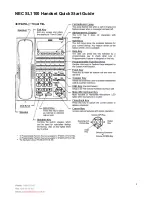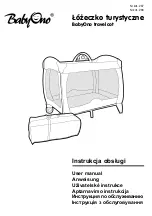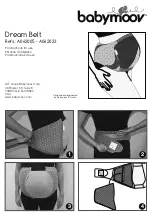
17
2.2.8 VERROUILLAGE DU CHÂSSIS AU TRANSPORT
Verrouillage du châssis
Avant toute opération de repliage, vérifiez que les 2 crochets de
verrouillage soient libres (A). Dans cette position, le verrouillage du
châssis avec les crochets est automatique.
Un indicateur visuel (B) permet depuis la cabine du tracteur de vérifier si
les crochets sont libres ou non:
- Les deux pointes se rejoignent, le crochet est libre ( ).
- Les deux pointes ne se rejoignent pas, le crochet est verrouillé ( ).
Le semoir étant posé sur le sol:
- Actionner les vérins pour replier les ailes
- Les ailes se replient jusqu’en butée (C).
- Les crochets de verrouillage se positionnent automatiquement (B).
- Le semoir est prêt pour le transport.
Déverrouillage du châssis
- Descendre du tracteur pour enclencher les crochets de verrouillage
(E). Ne pas oublier de faire les 2 côtés.
- Actionner les vérins de repliage pour déplier les ailes.
Butée de repliage
Une vis réglable (C) permet la butée de la bielle lors du repliage.
2.2.9 CHÂSSIS FLOTTANT
Ce châssis se comporte en flottant, c’est-à-dire que les ailes sont
indépendantes de la partie centrale au travail. Son utilisation est
préconisée pour des terrains accidentés.
Ce châssis dispose d’une butée basse sur chaque bielles (F). Le
décalage des ailes en butée basse est de 45 mm.
2.2.8 LOCKING THE FRAME FOR TRANSPORTATION
Locking the frame
Before any folding manoeuvre, check that the 2 catches are free (A). In
this position, locking of the frame with the catches is automatic.
A visual indicator (B) allows the driver to check whether or not the
catches are free, from the tractor cab:
-The two tips are meeting, the catch is free ( ).
- The two tips are not meeting, the catch is locked ( ).
With the planter placed on the ground:
- Activate the cylinders to fold the wings
- The wings fold until reaching the stop position (C).
- The catches position themselves automatically (B).
- The planter is ready for transportation.
Unlocking the frame
- Come out of the tractor to lock the catches (E). Remember to do both
sides.
- Activate the folding cylinders to unfold the wings.
Folding limit stop
An adjusting screw (C) allows the connecting rod to be stopped when
folding.
2.2.9 FLOATING FRAME
This frame has a floating mode, i.e. the wings are independent from the
central section when in operation. We recommend using this mode for
uneven ground.
This frame has a lower stop position on each of the connecting rods (F).
The distance of the wings in lower stop position is 45 mm.
2.2.8 VERRIEGELN DES RAHMENS WÄHREND DES
TRANSPORTS
Verriegeln des Rahmens
Sich vor jedem Einfahren davon überzeugen, dass die 2
Verriegelungshaken frei sind (A). In dieser Position erfolgt das Verriegeln
des Rahmens mit den Haken automatisch.
Eine Sichtanzeige (B) ermöglicht, vom Führerstand des Traktors aus zu
prüfen, ob die Haken frei sind oder nicht:
- Die beiden Spitzen berühren sich: der Haken ist frei ().
- Die beiden Spitzen berühren sich nicht: der Haken ist verriegelt ().
Die Sämaschine ist am Boden abgesetzt:
- Die Zylinder betätigen, um die Flügel einzufahren
- Die Flügel werden bis zum Anschlag eingefahren (C).
- Die Verriegelungshaken positionieren sich automatisch (B).
- Die Sämaschine ist transportbereit.
Entriegeln des Rahmens
- Vom Traktor steigen und die Verriegelungshaken einrücken (E). Nicht
vergessen, dies auf beiden Seiten zu tun.
- Die Einfahrzylinder betätigen, um die Flügel auszufahren.
Einfahranschlag
Eine Stellschraube (C) ermöglicht den Anschlag der Schubstange beim
Einfahren.
2.2.9 SCHWIMMENDER RAHMEN
Dieser Rahmen verhält sich schwimmend, d. h. die Flügel sind während
der Arbeit beweglich am Mittelteil eingehängt. Er wird für einen Einsatz
auf unebenem Gelände empfohlen.
Der Rahmen hat an jeder Schubstange einen unteren Anschlag (F). Der
Flügelversatz am unteren Anschlag beträgt 45 mm.
2.2.8 BLOQUEO DEL CHASIS EN EL TRANSPORTE
Bloqueo del chasis
Antes de cualquier operación de plegado, comprobar que los 2 ganchos
de bloqueo están libres (A). En esta posición, el bloqueo del chasis con
los ganchos es automático.
Un indicador visual (B) permite desde la cabina del tractor comprobar si
los ganchos están libres o no:
- ambos puntos se juntan, el gancho está libre ();
- ningún punto se junta, el gancho está bloqueado ().
La sembradora está colocada en el suelo:
- Accionar los cilindros para plegar las alas.
- Las alas se pliegan hasta el tope (C).
- Los ganchos de bloqueo se posicionan automáticamente (B).
- La sembradora está lista para el transporte.
Desbloqueo del chasis
- Bajar del tractor para enganchar los ganchos de bloqueo (E). No
olvidar hacerlo en los 2 lados.
- Accionar los cilindros de repliegue para desplegar las alas.
Tope de repliegue
Un tornillo regulable (C) permite que la biela haga tope durante el
repliegue.
2.2.9 CHASIS FLOTANTE
Este chasis es flotante, es decir que las alas son independientes de
la parte central durante el trabajo. Se recomienda su uso en terrenos
accidentados.
Este chasis dispone de un tope bajo en cada biela (F). La desviación de
las alas en tope bajo es de 45 mm.
Содержание TFC 2 VB
Страница 14: ...12 ...
Страница 16: ...14 A ...
Страница 18: ...16 A B C D E B F ...
Страница 20: ...1 2 3 4 5 6 18 ...
Страница 22: ...20 2 1 7 8 3 4 5 6 ...
Страница 24: ...22 ...
Страница 25: ...23 ...
Страница 28: ...26 A C B D E F G ...
Страница 30: ...28 F A B C ITALY B A E DANGER D ...
Страница 34: ...32 16h 16h 8h 8h 8h 8h 8h 8h ...
Страница 36: ...34 E F G A B D C ...
Страница 38: ...36 ...
Страница 40: ...38 A B D C ...
Страница 42: ...40 F E ...
Страница 46: ...44 A B ...
Страница 51: ...49 PIÈCES DE RECHANGE SPARE PARTS ERSATZTEILE PIEZAS DE REPUESTO ...
Страница 75: ......
















































